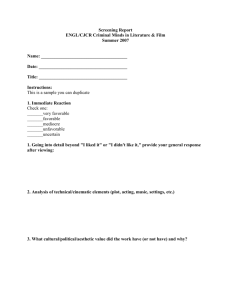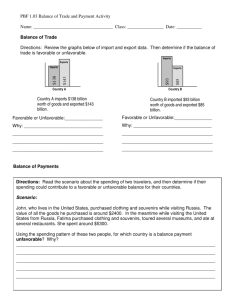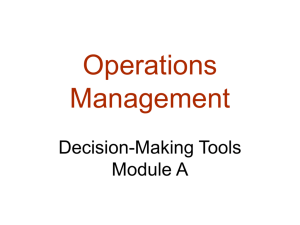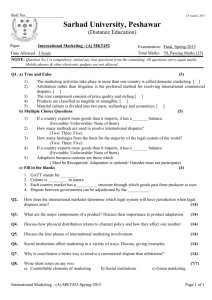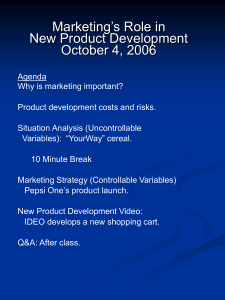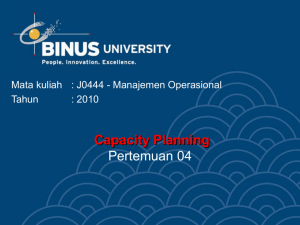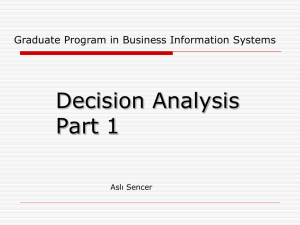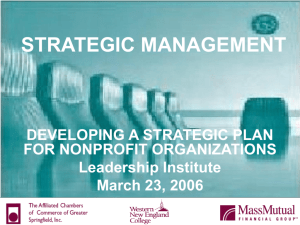Chapter 1, Heizer/Render, 5th edition
advertisement
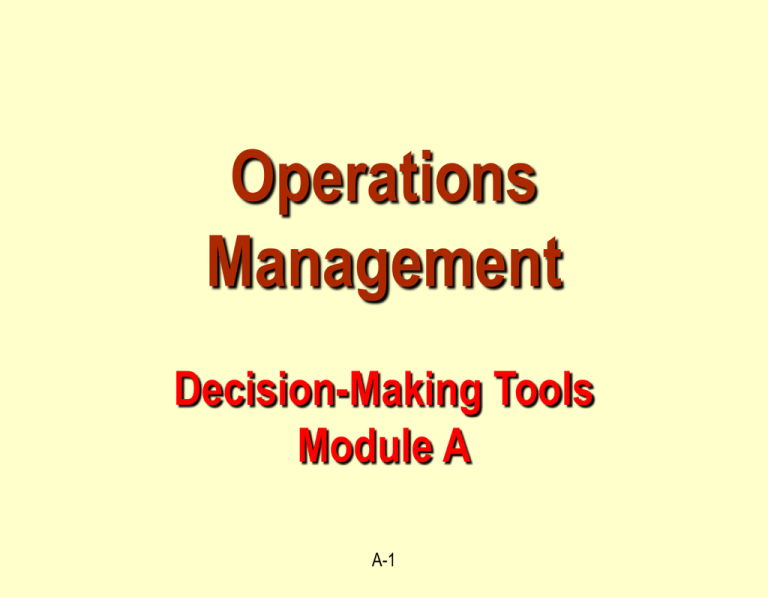
Operations Management Decision-Making Tools Module A A-1 Outline Decision Making & Models. Decision Tables. Decision making under uncertainty. Decision making under risk. Expected value of perfect information (EVPI). Decision Trees. A-2 The Decision-Making Process Quantitative Analysis Problem Logic Historical Data Marketing Research Scientific Analysis Modeling Qualitative Analysis Emotions Intuition Personal Experience and Motivation Rumors A-3 Decision Models and Scientific Management Can Help Managers to: Gain deeper insights into the business. Make better decisions! Better assess alternative plans and actions. Quantify, reduce and understand the uncertainty surrounding business plans and actions. A-4 Steps to Good Decisions Define problem and influencing factors. Establish decision criteria. Select decision-making tool (model). Identify and evaluate alternatives using decision-making tool (model). Select best alternative. Implement decision. Evaluate the outcome. A-5 Benefits of Models Allow better and faster decisions. Less expensive and disruptive than experimenting with the real world system. Allow managers to ask “What if…?” questions. Force a consistent and systematic approach to the analysis of problems. Require managers to be specific about constraints and goals. A-6 Limitations of Models May be expensive and time-consuming to develop and test. May be unused, misused or misunderstood (and feared!). Due to mathematical and logical complexity. May downplay the value of qualitative information. May use assumptions that oversimplify the real world. A-7 Decision Theory Terms: Alternative: Course of action or choice. Decision-maker chooses among alternatives. State of nature: An occurrence over which the decision maker has no control. A-8 Decision Table States of Nature State 1 State 2 Alternative 1 Outcome 1 Outcome 2 Alternative 2 Outcome 3 Outcome 4 A-9 Example - Decision Making Under Uncertainty A firm has two options for expanding production of a product: (1) construct a large plant; or (2) construct a small plant. Whether or not the firm expands, the future market for the product will be either favorable or unfavorable. If a large plant is constructed and the market is favorable, then the result is a profit of $200,000. If a large plant is constructed and the market is unfavorable, then the result is a loss of $180,000. If a small plant is constructed and the market is favorable, then the result is a profit of $100,000. If a small plant is constructed and the market is unfavorable, then the result is a loss of $20,000. Of course, the firm may also choose to “do nothing”, which produces no profit or loss. A-10 Example - Decision Making Under Uncertainty States of Nature Alternatives Favorable Unfavorable Construct large plant Construct small plant Market $200,000 Market -$180,000 $100,000 -$20,000 $0 $0 Do nothing A-11 Decision Making Under Uncertainty - Criteria Maximax - Choose alternative that maximizes the maximum outcome for every alternative (Optimistic criterion). Maximin - Choose alternative that maximizes the minimum outcome for every alternative (Pessimistic criterion). Expected Value - Choose alternative with the highest expected value. A-12 Example - Maximax States of Nature Alternatives Favorable Unfavorable Construct large plant Construct small plant Market $200,000 Market -$180,000 $100,000 -$20,000 $0 $0 Do nothing Maximax decision is to construct large plant. A-13 Example - Maximin States of Nature Market $200,000 Market -$180,000 Minimum in Row -$180,000 $100,000 -$20,000 -$20,000 $0 $0 $0 Alternatives Favorable Unfavorable Construct large plant Construct small plant Do nothing Maximin decision is to do nothing. (Maximum of minimums for each alternative) A-14 Decision Making Under Risk Probabilistic decision situation. States of nature have probabilities of occurrence. Select alternative with largest expected value (EV). EV = Average return for alternative if decision were repeated many times. A-15 Expected Value Equation Number of states of nature N EV ( Ai ) = Value of Payoff V i * P (V i ) Probability of payoff i =1 = V 1 * P (V 1 ) + V 2 * P (V 2 ) + ... +V N * P (V N ) Alternative i A-16 Example - Expected Value Suppose: Probability of favorable market = 0.5 Probability of unfavorable market = 0.5 States of Nature Market $200,000 Market -$180,000 Expected Value $10,000 $100,000 -$20,000 $40,000 $0 $0 Alternatives Favorable Unfavorable Construct large plant Construct small plant Do nothing Decision is to “Construct small plant”. A-17 $0 Example - Expected Value Suppose: Probability of favorable market = 0.7 Probability of unfavorable market = 0.3 States of Nature Market $200,000 Market -$180,000 Expected Value $86,000 $100,000 -$20,000 $64,000 $0 $0 Alternatives Favorable Unfavorable Construct large plant Construct small plant Do nothing Now, decision is to “Construct large plant”. A-18 $0 Example - Expected Value Over what range of values for probability of favorable market is “Construct large plant” preferred? States of Nature Alternatives Favorable Unfavorable Construct large plant Construct small plant Do nothing Expected Value Market $200,000 Market -$180,000 380,000x - 180,000 $100,000 -$20,000 120,000x - 20,000 $0 $0 Solve for x: 380000x-180000 > 120000x-20000 A-19 Example - Expected Value Over what range of values for probability of favorable market is “Construct large plant” preferred? Solve for x: 380000x - 180000 > 120000x - 20000 x > 0.6154 So, as long as probability of a favorable market exceeds 0.6154, then “Construct large plant”. A-20 Expected Value of Perfect Information (EVPI) EVPI places an upper bound on what one would pay for additional information. EVPI is the maximum you should pay to learn the future. EVPI is the expected value under certainty (EVUC) minus the maximum EV. EVPI = EVUC - maximum EV A-21 Expected Value Under Certainty (EVUC) n EVUC = (Best outcome for the state of nature j) * P(S j ) j =1 where: P(Sj ) = The probability of state of nature j. n = Number of states of nature. A-22 Example - EVUC States of Nature Alternatives Favorable Unfavorable Construct large plant Construct small plant Do nothing Market $200,000 Market -$180,000 $100,000 -$20,000 $0 $0 Best outcome for Favorable Market = $200,000 Best outcome for Unfavorable Market = $0 A-23 Expected Value of Perfect Information Suppose: Probability of favorable market = 0.5 Probability of unfavorable market = 0.5 EVPI = EVUC - max(EV) = ($200,000*0.50 + 0*0.50) - $40,000 = $60,000 Thus, you should be willing to pay up to $60,000 to learn whether the market will be favorable or not. A-24 Expected Value of Perfect Information Now suppose: Probability of favorable market = 0.7 Probability of unfavorable market = 0.3 EVPI = EVUC - max(EV) = ($200,000*0.70 + 0*0.30) - $86,000 = $54,000 Now, you should be willing to pay up to $54,000 to learn whether the market will be favorable or not. A-25 Decision Trees Graphical display of decision process. Used for solving problems with several sets of alternatives and states of nature (sequential decisions). Decision tables can not be used for more than one decision. Expected Value criterion is used. A-26 Using Decision Trees Define the problem. Draw the decision tree. Assign probabilities to all states of nature. Estimate payoffs for each combination of alternatives and states of nature. Solve the problem: Compute expected values for each state-of-nature node moving right to left. Select decisions that maximize expected value. A-27 Decision Theory Terms: Alternative: Course of action or choice. State of nature: An occurrence over which the decision maker has no control. Symbols used in decision tree: A decision node from which one of several alternatives may be selected. A state of nature node out of which one state of nature will occur. A-28 Decision Tree State 1 1 State 2 State 1 2 Decision Node State 2 Outcome 1 Outcome 2 Outcome 3 Outcome 4 State of Nature Node A-29 Decision Tree for Example Favorable Mkt (0.7) Unfavorable Mkt (0.3) Favorable Mkt (0.7) Unfavorable Mkt (0.3) $200,000 -$180,000 $100,000 -$20,000 $0 A-30 Decision Tree for Example Solution $86,000 Favorable Mkt (0.7) Unfavorable Mkt (0.3) $64,000 Favorable Mkt (0.7) Unfavorable Mkt (0.3) $0 $200,000 -$180,000 $100,000 -$20,000 $0 A-31 Decision Tree Example A firm can build a large plant or small plant initially (for a new product). Demand for the new product will be high or low initially. The probability of high demand is 0.6. (The probability of low demand is 0.4.) If they build “small” and demand is “low”, the payoff is $40 million. If they build “small” and demand is “high”, they can do nothing and payoff is $45 million, or they can expand. If they expand, there is a 30% chance the demand drops off and the payoff will be $35 million, and a 70% chance the demand grows and the payoff is $48 million. If they build “large” and demand is “high”, the payoff is $60 million. If they build “large” and demand is “low”, they can do nothing and payoff is -$10 million, or they can reduce prices and payoff is $20 million. Determine the best decision(s) using a decision tree. A-32 Decision Tree Example Three decisions: 1. Build “Large” or “Small” plant initially. 2. If build “Small” and demand is “High”, then “Expand” or “Do nothing”. 3. If build “Large” and demand is “Low”, then decide to “Reduce prices” or “Do nothing”. Two states of nature: 1. Demand is “High” (0.6) or “Low” (0.4) initially. 2. If build “Small”, demand is “High”, and decision is “Expand”, then demand “Grows” (0.7) or demand “Drops” (0.3). A-33 Decision Tree Demand grows (0.7) Demand drops (0.3) $48 $35 2 $45 $40 1 $60 Reduce prices 3 Do nothing A-34 $20 -$10 Decision Tree Solution Work right to left (from end back to beginning). Start with Decision 3: “Reduce prices” or “Do nothing”. Choose “Reduce prices” (20 > -10). A-35 Decision Tree Demand grows (0.7) Demand drops (0.3) $48 $35 2 $45 $40 1 $60 $20 3 Reduce prices Do nothing A-36 $20 -$10 Decision Tree Solution Consider Decision 2: “Expand” or “Do nothing”. To compare outcomes we need expected value if we “Expand”: (48*0.7) + (35*0.3) = 44.1 Choose “Do nothing” (45 > 44.1). A-37 Decision Tree $44.1 Demand grows (0.7) Demand drops (0.3) $45 2 $45 $48 $35 $45 $40 1 $60 $20 3 Reduce prices Do nothing A-38 $20 -$10 Decision Tree $44.1 Demand grows (0.7) Demand drops (0.3) $45 2 $45 $43 $48 $35 $45 $40 1 $60 $44 $20 3 Reduce prices Do nothing A-39 $20 -$10 Decision Tree Final Solution Decisions: 1. Build “Large”. 2. If demand is “Low”, then “Reduce prices”. Expected payoff = $44 million. A-40 Larger Decision Tree $10 0.4 2 0.2 0.6 0.3 $8 $12 $9 0.5 1 $11 0.4 0.6 3 0.4 0.3 0.3 A-41 $6 $12 $8 $9 $8 Larger Decision Tree - Solution $10 $10.4 2 $10.4 0.2 $10.28 0.4 0.6 0.3 $8 $12 $9 0.5 1 $9.6 $11 0.4 0.6 $9.6 3 $8.3 0.4 0.3 0.3 A-42 $6 $12 $8 $9 $8
